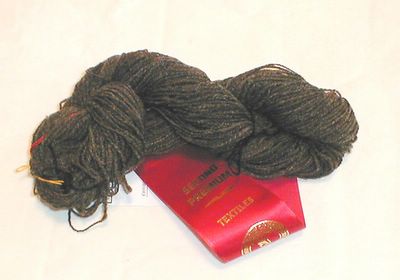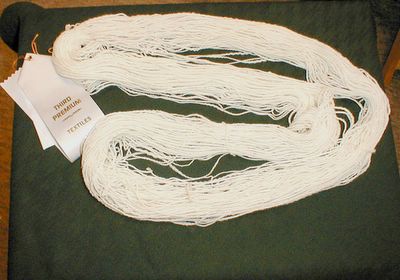Here finally are the pictures of the five skeins I did for this year's state fair. There were probably anywhere from four to eight skeins in most categories entered, and the judging was tough, based on the comments written on my skeins from the judge. I was glad to see the forty or so skeins this year, and keep encouraging other spinners in my area to enter, I want this category to stay active at our fair. They have also changed many of the categories, another good thing. When I started entering skeins about four years ago, most categories were based on yarns spun from the Lincoln fiber! That happens because anyone can support a category at the state fair, simply by paying the premiums for that category, and most of the spinning categories were being supported by a Lincoln breeder. The support has been picked up now mostly by the local spinning guilds and so their categories have broadened.
I STILL find the designer category to be the most challenging. That's good, because I would not continue to enter if there were no challenges. I must admit I thought I had a first place winner this year, with my Jacob self striping, navaho plied yarn, but was beaten by a blended yarn. The year I entered a blended yarn, I was beaten by a uniquely plied yarn. And these were judged by the same judge, so I still can not figure out exactly what in the judge's mind makes a designer yarn. I know what it means in my mind, a yarn that is specifically spun with a final knitted or woven design in mind.
What did I learn from this year's judging of my skeins? First and foremost, that I am not paying attention to small details while spinning. I am not being a perfectionist when I spin. It easy to overlook the need for every twist to be the same, every ply to be even. The final handspun skein always looks wonderful to me, because it is so unique. It is exactly that uniqueness that I strive for in handspun. However, that attitude does not win first place ribbons, and this year's lesson is that if I want to enter skeins in a competition, they have to be as perfect as possible, not unique. I feel I am a good spinner, but not by a long shot a consistent spinner, and that is what wins the first place. I can understand how a judge has to use consistancy as a standard, because every skein is lovely, soft, unique.
I learned alot about a judge's job and attitude this year by being the scribe for the quilt judge. That meant I sat at a table behind the judge and wrote down every comment made about each and every quilt. There are almost 30 different quilting categories at our fair, and often dozens of entries in each category. That adds up to almost a 10 hour day for a judge to look at and comment on each one. And what I learned as I wrote and listened was that a judge has to be completely ignore the 'WOW' factor of a quilt laying in front of them and fall back on the technical skills that created that quilt. Is the border straight, are the pieces well fitted, is the handquilting even? Often I would see a quilt spread out and think, 'Oh my that is just perfect' and then have to write as the judge spoke, that those technical skills I just mentioned were lacking.
So what I have been trying to say in those two wordy paragraphs is that no matter what is being judged, it finally comes down to the technical skills involved in making that item. And that is the lesson I will take to next years entries. I have many second place wins this year instead of firsts, because my plying was slightly overdone, my singles not exactly even, and worse of all, I did not tie the skeins with the same yarn as the skein. I did on a few, but not all, and it's those little details I will have to remember for next year.
Oh, you wanted pictures! OK here they are.
Jacob self striping designer yarn


For this designer yarn, I used part of the Jacob fleece I purchased this spring at Greencastle. I took solid areas of four different colors from the fleece and washed them. I combed each color separately to make top in four different colors. I then divided the top into color roations based mostly on weight. I spun these color rotations in order making one long single with long stripes of color. Then I navaho plied that single, keeping the colors matching, so I ended up with stripes of color. The swatch next to the skein knitted off from the resulting yarn, I did not change yarns to get the effect. It is a self striping yarn.
Spindle Spun Rambouilett


This category called for an all wool plied handspun yarn. I started with a raw Rambouillet fleece and pulled the finest fibers to wash. This was combed to make top. I drop spindle spun the top, and then plied the yarn on my Roberta. This is a wonderful yarn, I will have to make myself something special with it sometime, I have no plans to let this yarn out of my sight.
Dyed merino and angora skein


This category called for a blended yarn of at least 50% wool. I did this skein from one of the rovings I make to sell. The blend is 70% white merino and 30% dyed angora, in this skein the angora is a very pale turquoise color. The yarn is a bulky weight, I think it would make a wonderful hat for a toddler.
Yarn spun from Jacob locks


This category called for any natural colored wool. This is also a skein from the Jacob fleece I bought this spring. For this skein I took locks of wide variation in colors, washed them to keep the locks intact, and then combed them with a metal tooth dog comb, again keeping the lock intact. Then I just grab a lock at random and spun the lock until it was gone. I made no attempt to color match anything, and did a normal plying of two singles. There is no swatch with this entry, but I know it will knit up into a lovely tweed. There are two washed and combed locks beside the skein to show how they look right before spinning. The prep to do this is tedious, but I love spinning locks. Somehow the lock just magically and completely disappears into the yarn, unlike other forms of prep that can have so much waste.
Merino skein


And finally the last category is the obligatory merino skein. I have such a love/hate feeling for merino. Yes, it is next to the skin soft, and I love the yarn for that reason. But try as I may, I can not get a lace weight merino yarn and I hate a fiber that won't do what I want. Merino have a mind of it's own, and will poof out three times its WPI when washed. I tried not washing this skein before entering it, but the judge caught that
Thanks for your interest (since you got this far). I love sharing what I learn each time I enter a competition.
CW
3 comments:
Your skeins are lovely---I especially like the one spun from Jacob's locks. I admire that you are trying to perfect the technical aspects of spinning---after spinning for almost five years, I'm still at the "Hey, look! I actually made me some yarn!" stage.
Brenda.
Laugh! Oh I am still very much at that stage too, I hope I never lose that awe at what fiber can become. That's why I write such big and serious posts about any competition I enter, the challenge is so different from the spinning I do the rest of the year.
CW
Congratulations on the ribbons! You have a great state fair, and are so lucky to have a category for spinners! As usual, I learn so much from your posts--thanks for explaining everything in such detail.
Post a Comment